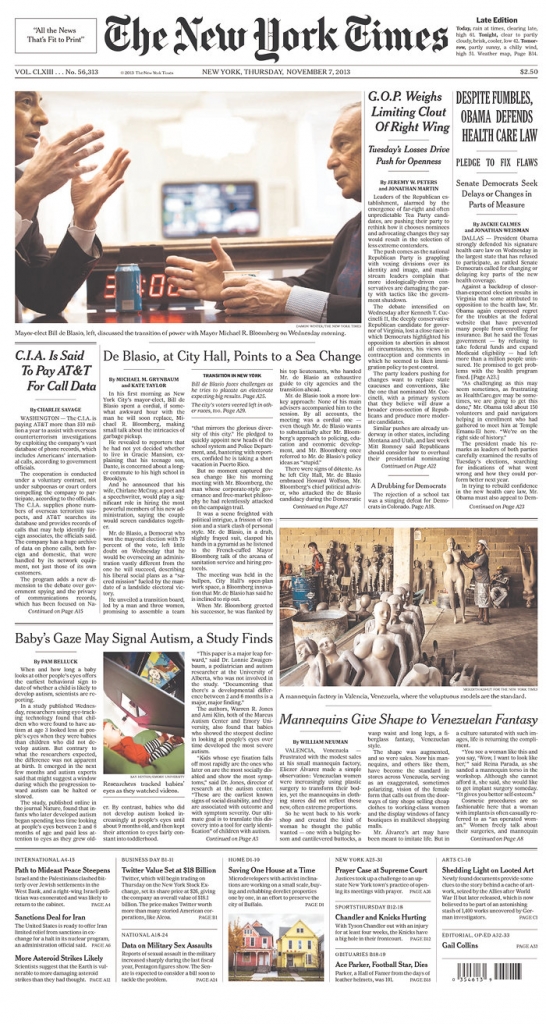Lesson Outline
November 8, 2013
 This article from the New York Times revealed that the Central Intelligence Agency is paying more than $10 million a year to AT&T, America's largest telecommunications provider, for assistance with overseas counter-terrorism investigations in “exploiting the company’s vast database of phone records, which includes Americans’ international calls.” As reporter Charlie Savage noted, “The program adds a new dimension to the debate over government spying and the privacy of communications records, which has been focused on National Security Agency programs in recent months.” The disclosure also shed “further light on the ties between intelligence officials and communications service providers. And it shows how agencies beyond the N.S.A. use meta-data — logs of the date, duration and phone numbers involved in a call, but not the content — to analyze links between people through programs regulated by an inconsistent patchwork of legal standards, procedures and oversight.”
This article from the New York Times revealed that the Central Intelligence Agency is paying more than $10 million a year to AT&T, America's largest telecommunications provider, for assistance with overseas counter-terrorism investigations in “exploiting the company’s vast database of phone records, which includes Americans’ international calls.” As reporter Charlie Savage noted, “The program adds a new dimension to the debate over government spying and the privacy of communications records, which has been focused on National Security Agency programs in recent months.” The disclosure also shed “further light on the ties between intelligence officials and communications service providers. And it shows how agencies beyond the N.S.A. use meta-data — logs of the date, duration and phone numbers involved in a call, but not the content — to analyze links between people through programs regulated by an inconsistent patchwork of legal standards, procedures and oversight.”
The shocking front-page revelations were made on the strength on statements attributed only to unnamed “government officials.” Neither of the only two named sources, CIA spokesman Dean Boyd and AT&T's Mark Siegel, confirmed the program, and both said their institutions were acting lawfully. So how can a careful news consumer judge the accuracy and reliability of such a report? This article provides for rich discussion of several core News Literacy concept, including Source Analysis, Truth and Verification, and why News Literacy matters.
QUESTIONS:
- What did you learn from this article? What do you still want to know? What is not being said?
- How can you tell if the information in this article is reliable—especially since the sources are all anonymous? How can you evaluate the sources given they are only identified as “government officials?” Does the fact that they are unnamed make you question the information, since they aren't willing to put their names behind their assertions?
- Does the explanation – that the officials remained anonymous because the information they were divulging is classified – satisfy you? Why or why not?
- Does the lack of named, authoritative sources for the story make you feel that it doesn't hold a lot of weight? Did it seem that the reporter was filling in the gaps where sources should have?
- What other clues are there to help you determine the credibility of this information? Does the reputation of the reporter and the news outlet influence your decision? If so, how?
- What if anything does the front-page placement of the article in the New York Times tell you?
- The author includes information regarding AT&T's past work with the FBI and with other Federal offices. What context if any does this add to the story?
ADDITIONAL LINKS AND RESOURCES:
- Documents Show Link Between AT&T and Agency in Eavesdropping Case in http://www.nytimes.com/2006/04/13/us/nationalspecial3/13nsa.html
- Drug Agents Use Vast Phone Trove, Eclipsing NSA's
http://www.nytimes.com/2013/09/02/us/drug-agents-use-vast-phone-trove-eclipsing-nsas.html - New York Times' Front page for November 6, 2013 -- The article referenced in this lesson is printed on the left side of the page.

-
0 comments
-
0 saves
-
Share
